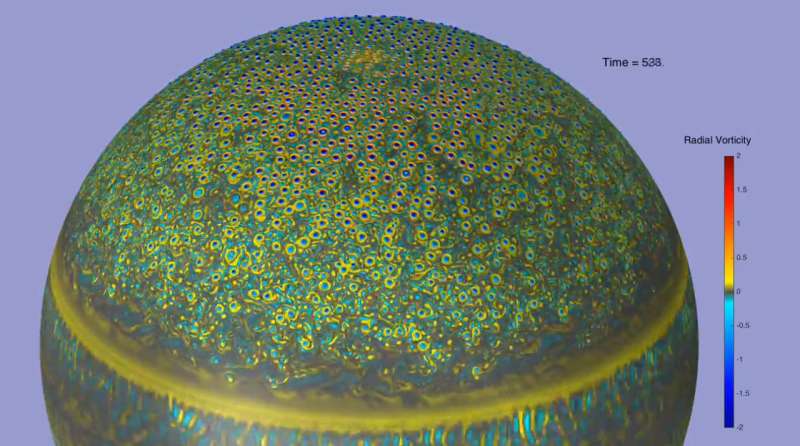Supercomputer simulates dynamic magnetic fields of Jupiter, Earth, Sun

As the Juno space probe approached Jupiter in June last year, researchers with the Computational Infrastructure for Geodynamics' Dynamo Working Group were starting to run simulations of the giant planet's magnetic field on one of the world's fastest computers. While the timing was coincidental, the supercomputer modeling should help scientists interpret the data from Juno, and vice versa.
"Even with Juno, we're not going to be able to get a great physical sampling of the turbulence occurring in Jupiter's deep interior," Jonathan Aurnou, a geophysics professor at UCLA who leads the geodynamo working group, said in an article for Argonne National Laboratory news. "Only a supercomputer can help get us under that lid."
Computational Infrastructure for Geodynamics is headquartered at UC Davis. The CIG describes itself as a community organization of scientists that disseminates software for geophysics and related fields. The CIG's Geodynamo Working Group, led by Aurnou, includes researchers from UC Berkeley, UC Boulder, UC Davis, UC Santa Cruz, the University of Alberta, UW-Madison and Johns Hopkins University.
Earth's magnetic field is an essential part of life on our planet—from guiding birds on vast migrations to shielding us from solar storms. Scientists think Earth's magnetic field is generated by the swirling liquid iron in the planet's outer core (called the geodynamo), but many mysteries remain. For example, observations of magnetic fields encircling other planets and stars suggest there could be many ways of making a planet-sized magnetic field. And why has the field has flipped polarity (swapping magnetic north and south) more than 150 times in the past 70 million years?
"The geodynamo is one of the most challenging geophysical problems in existence—and one of the most challenging computational problems as well," said Louise Kellogg, director of the CIG and a professor in the UC Davis Department of Earth and Planetary Sciences.
The working group was awarded 260 million core hours on the Mira supercomputer at the U.S. Department of Energy's Argonne National Laboratory – rated the sixth-fastest in the world—to model magnetic fields inside the Earth, Sun and Jupiter.
The CIG project was funded by the Department of Energy's Innovative and Novel Computational Impact on Theory and Experiment, or INCITE, program, which provides access to computing centers at Argonne and Oak Ridge national laboratories. Researchers from academia, government and industry will share a total of 5.8 billion core hours on two supercomputers, Titan at Oak Ridge National Laboratory and Mira at Argonne.
Provided by UC Davis





















